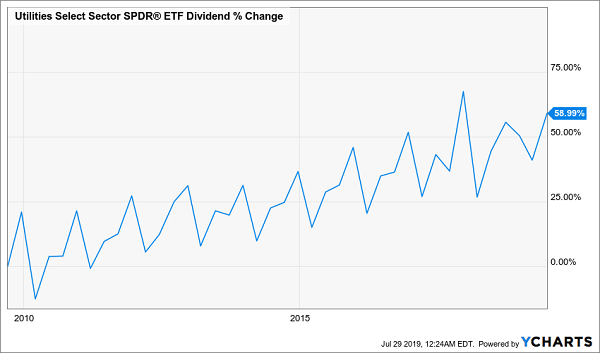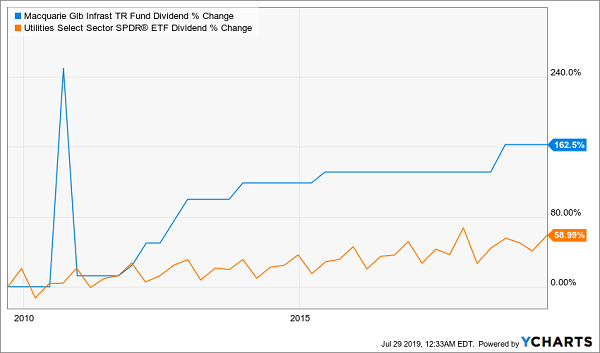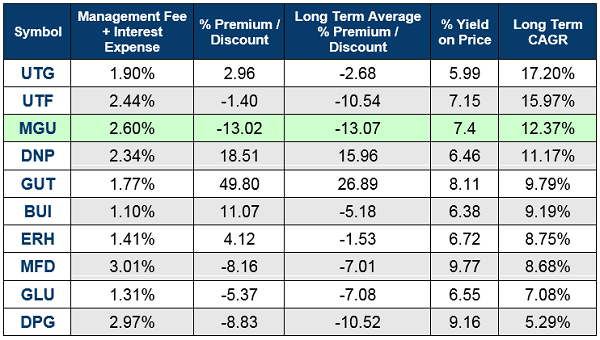I run into a lot of investors who think retirement investing is a two-act play.
In Act 1, when you’re younger, you try to balloon your nest egg with high-risk growth stocks that pay little (and often no) dividends.
Then, in Act 2, as you near—and enter—retirement, you pivot to the big dividends you need to pay your bills.
Trouble is, this approach exposes you to far too much risk, so today I’m going to show you a better way.
Your Best Play: Big Dividends and Growth—Right Now
I’m talking about 10 funds that can hand you dividends up to 9.8% right now, plus annual returns of 10% or more.
More on those—and one, in particular, that should be on your short list now—shortly.
For now, these funds all have one thing in common (beyond their outsized dividend payouts): they invest in utilities, a group of stocks whose high dividends tend to grow over time, thanks to rising demand for power, water and life’s other essentials.
I know what you’re thinking: how the heck can these funds get dividends up to 9.8% from utilities? The big names in the sector—like Southern Company (SO), Duke Energy (DUK) and American Electric Power (AEP) yield 4.3%, max.
I’ll explain in just a few seconds more. First, let me tell you what these funds are not: ETFs.
The benchmark Select Sector Utilities SPDR ETF (XLU) offers diversified utility exposure, sure. But it yields just 3% today—though its dividend is growing (albeit slowly):
XLU’s Sleepy Payout Growth …

If you have time, buying and holding XLU will get you yield much bigger than 3% on your original investment. Say, for example you bought the fund a decade ago—today you’d be pocketing a 6.7% yield on your initial buy, thanks to the growth of XLU’s price and dividend:
… Builds Your Yield Over (a Long) Time

But we don’t want to wait 10 years to get a 6%+ yield! We want those payouts today—and as I said off the top, there are 10 unique funds that can get us there right now.
Financial Freedom in a Flash
The secret? Closed-end funds (CEFs)—in particular those that hold utilities. Yields of 6% (and yes, even 9.8%) are common in this space, as is the potential for bigger total returns than you’d see from individual utility stocks or ETFs.
Let’s do a quick dive into how this is possible with CEFs. Then I’ll reveal those 10 utility CEFs paying up to 9.8% in just a few seconds more. I’ll also show you a standout utility-CEF pick—a fund boasting a growing 7.4% dividend that’s demolished the sector as a whole in the past decade.
How CEFs Pay Massive Dividends
CEFs issue a fixed number of shares to invest in a particular asset class or sector, and those shares trade on the open market. As a result, a CEF’s market price is often higher or lower than the net asset value (NAV) of the assets in its portfolio.
Here’s the upshot: when a CEF’s NAV is higher than its market price, you not only get those assets at a discount, but you also get the dividend at a discount, since the fund managers are mainly focused on the yield on NAV. That can boost a CEF’s yield considerably.
Let me show you how this works.
Right now, my CEF Insider service tracks 10 CEFs specializing in utilities. Each pays a dividend much higher than XLU, with yields on their market prices ranging from 6% to 9.8%. And because of their different discounts, the yield on NAV these funds need to earn to sustain those payouts can vary considerably:

Let’s zero in on the Macquarie Global Infrastructure Total Return Fund (MGU), with a 13.02% discount to NAV. That means it only needs to earn 6.31% (its current yield on NAV) to sustain its 7.4% yield (on market price).
That’s partly why MGU been able to sustain its payout and grow it almost three times faster than XLU in the last decade.
A 7.4% Dividend That’s Growing Like a Weed

With its big discount, MGU is one of the more appealing utilities funds. But how has it performed in the long run?
Very well indeed.

This chart shows the long-term annualized return (either 10 years or since inception, whichever is shortest) of each fund.
MGU ranks third, despite having the largest discount of any utilities fund. While that discount is slightly smaller than MGU’s long-term average, the difference is so small as to not be a worry. That’s also a big contrast from the BlackRock Utilities Infrastructure and Power Opportunities Trust (BUI), with an 11.1% premium that’s far ahead of its long-term-average 5.2% discount to NAV.
Plus, MGU has crushed XLU, the benchmark utility ETF.
MGU Tops the Utility Sector

The bottom line here is pretty clear: by going the CEF route—and through MGU, in particular—shareholders have grabbed a bigger, faster-growing income stream and larger total returns than the “safe” index investor.
5 More Big Dividends (8%+) the ETF Companies Hate
There’s a simple reason why you never hear about CEFs in the media or from your adviser: the ETF companies throw huge marketing dollars at “dumb” funds like XLU.
I say XLU (and other ETFs) are “dumb” because they use a computer algorithm to track an underlying index—in XLU’s case, a market-cap-weighted basket of utilities that mainly trade on the S&P 500.
But ETFs pay off for the big fund companies—with no management team to pay, the money these funds bring in is mostly profit! But as I just showed you with MGU, ETFs often underperform high-yielding CEFs with a veteran pro at the top.
And dividends?
ETFs aren’t in the same league as CEFs, especially when you consider that XLU is the cream of the ETF-dividend crop. The popular SPDR S&P 500 ETF (SPY) is even worse, with a pathetic 1.8% payout!
So let’s look past the marketing hype with 5 other CEFs I want to show you today. They come from across the economic spectrum (with the exception of utilities, which makes them a great fit with MGU).
Here’s what you get with this high-yielding CEF “5 pack” (which I’ll reveal when you click right here):
- Massive dividends—I’m talking 8%, on average, with the highest yielder of the bunch above 9%.
- Incredible performance: One of these picks delivered a 929% return since inception, nearly 5 TIMES the market’s return in that time.
- Outstanding discounts—These funds all trade at big discounts to NAV—I’m talking 10% and even 11.3%—setting us up for big upside (I’m forecasting 20%+ price gains in the next 12 months).

Recent Comments